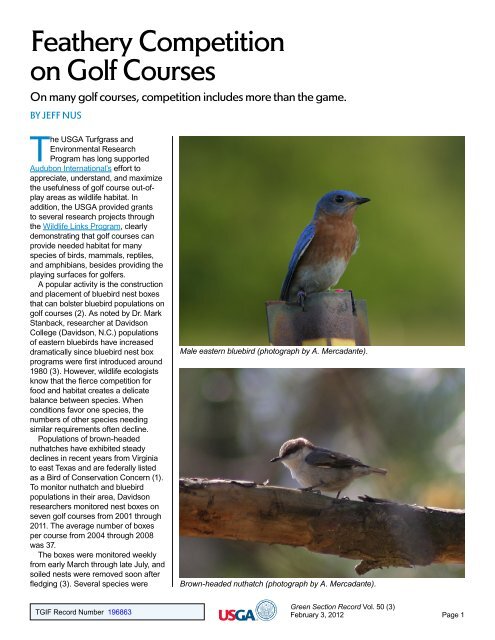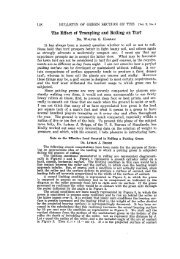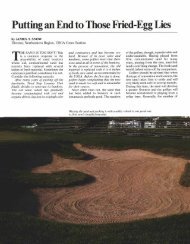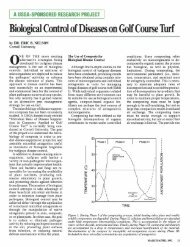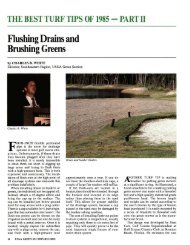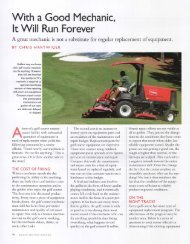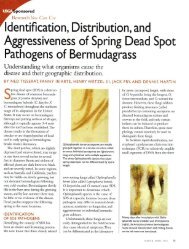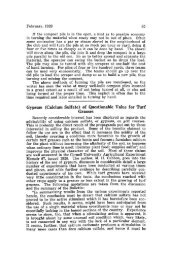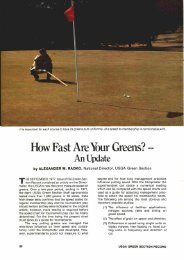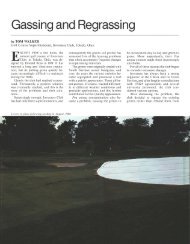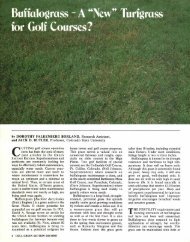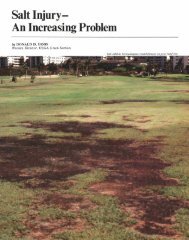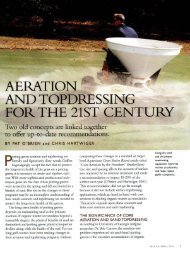Feathery Competition on Golf Courses - USGA Green Section Record
Feathery Competition on Golf Courses - USGA Green Section Record
Feathery Competition on Golf Courses - USGA Green Section Record
Create successful ePaper yourself
Turn your PDF publications into a flip-book with our unique Google optimized e-Paper software.
Pole-mounted nest box with predator guard.found to use these next boxes besidesnuthatches and bluebirds. Theyincluded Carolina chickadees, housesparrows, tree swallows, tufted titmice,house wrens, and even southern flyingsquirrels. However, it was the rarity ofnuthatches that had these scientistsasking, “Why?”Researchers acknowledge thatpopulati<strong>on</strong> declines are likely due,in part, to extensive logging, whichlimits cavity-nest sites for this species,although they suspected other factors.“Habitat degradati<strong>on</strong> c<strong>on</strong>tinues to bethe major cause of populati<strong>on</strong> declinesfor many birds. But we often lack anuanced understanding of how particularhabitat deficits impact the birds inquesti<strong>on</strong>,” says Dr. Stanback, projectleader.Dr. Stanback and his colleagueswere determined to identify factorsthat were c<strong>on</strong>tributing to the lack ofobserved nuthatches in the samplednest boxes, and to determine what, ifanything, could be d<strong>on</strong>e to reverse thistrend. The first questi<strong>on</strong> was, “Doescompetiti<strong>on</strong> with bluebirds over nestboxes prevent breeding bynuthatches?”To answer this questi<strong>on</strong>, they hadto exclude bluebirds from the nestboxes. The standard nest boxes wereequipped with a 38-mm (1.5-inch)entry hole, which accommodatesbluebirds and all other smaller cavitynesters.Prior to the 2005 seas<strong>on</strong>, <strong>on</strong>approximately a quarter of the boxes<strong>on</strong> four of the golf courses, theyreplaced fr<strong>on</strong>t plates with <strong>on</strong>es with28-mm (1.1-inch) holes to exclude thelarger bluebirds. Prior to the 2008seas<strong>on</strong>, hole size was reduced <strong>on</strong>another <strong>on</strong>e-third of the nest boxes <strong>on</strong>two additi<strong>on</strong>al courses. The resultsclearly showed that when competiti<strong>on</strong>from bluebirds for nest boxes waseliminated in this way, significantlymore nuthatches used those boxes tosuccessfully fledge their young.“For several years my students and Iobserved occasi<strong>on</strong>al nesting attemptsby brown-headed nuthatches <strong>on</strong> golfcourses where we were studyingbluebirds. However, most ended withbluebirds taking over the boxes. Theseusurpati<strong>on</strong>s prompted me to hypothesizethat bluebirds were m<strong>on</strong>opolizinggolf course nest boxes, and that <strong>on</strong>lyby excluding them could we see whatnuthatches were capable of,” explainsDr. Stanback. “Seeing so manysuccessful nuthatch nests was veryheartwarming. Nuthatches live inlarge family groups and are verycharismatic — you can’t help but rootfor the little guys.”Dr. Stanback and his colleaguesnote that nuthatches have beenhistorically associated with maturepine forests, so the sec<strong>on</strong>d questi<strong>on</strong>they wanted to investigate was, “Towhat extent is nest box occupancy bynuthatches dependent <strong>on</strong> the proximity<strong>Green</strong> Secti<strong>on</strong> <strong>Record</strong> Vol. 50 (3)February 3, 2012 Page 2
of pine forests?” Stanback and histeam carefully categorized the nestbox proximity to the three nearest pinetrees and m<strong>on</strong>itored the use of boththese large- and small-hole nest boxes<strong>on</strong> four golf courses. They found thatneither bluebirds nor nuthatchesshowed preference regarding pinedensity, although nuthatches usedbluebird-proof nest boxes with smallerholes far more than expected.“The c<strong>on</strong>venti<strong>on</strong>al wisdom is thatthese nuthatches require mature pinestands,” says Dr. Stanback. “While Irecognize that brown-headed nuthatchesneed some pines, I wassurprised that the minimum was so . . .minimal. We had successful nuthatchnests in open fields with no pines insight. The key really does seem to bepreventi<strong>on</strong> by bluebirds.”The third questi<strong>on</strong> Dr. Stanbackand his colleagues asked was, “Canbluebirds actively displace nuthatchesfrom nest boxes?” To answer this, theyincreased the size of the entry holes(making them bluebird-accessible) <strong>on</strong>nest boxes that were previouslybluebird-proof (having smaller entryholes) and c<strong>on</strong>tained nuthatch nests in2007. The results were overwhelming.Nearly all of the 32 boxes used bynuthatches in 2007 were used bybluebirds in 2008 after the size of theentry holes was increased. In mostcases, bluebirds evicted nuthatchesthat were beginning to build nests.The results clearly indicated thatnest box occupancy favored bluebirdswhen the entry hole was large (1.5inches), but when bluebirds wereexcluded using smaller entry holes (1.1inches), nuthatches readily occupiednest boxes. The researchers asked thenext logical questi<strong>on</strong>, “Could pairingstandard (with larger holes) boxesallow bluebirds and nuthatches tocoexist?” In 2009, researchers pairedup most of the nest boxes at the localsix golf courses. Paired nest boxeswere typically 10 meters apart and had<strong>on</strong>e nest box with a small hole and <strong>on</strong>ebox with a larger hole, both nest boxeswith large holes, or both with smallholes.Results indicated that bluebirdswould not allow nuthatches to nest inadjacent larger-holed nest boxes, evenwhen bluebirds nested in <strong>on</strong>ly <strong>on</strong>e oftwo larger-holed nest boxes. However,when the pair of nest boxes included<strong>on</strong>e small and <strong>on</strong>e large entry hole,nuthatches were able to nest in thesmall-hole nest box in 74 out of the 139big/small box pairs. Thus, while pairingidentical larger-hole boxes may be aneffective strategy for some species,nuthatches appear not to benefit inany way from this practice.“Nest boxes can be incrediblyeffective c<strong>on</strong>servati<strong>on</strong> tools,” saysDr. Stanback. “For example, bluebirdlovers have increased bluebird numbersdramatically in recent decadessimply by making nest boxes availableto them. However, bluebirds are almosttoo good at taking advantage of nestboxes. A golf course superintendentwho installs 18 nest boxes may feelthat he is doing something great for allbirds. The fact is, 16 of those boxes willc<strong>on</strong>tain bluebirds, and if another 18boxes are installed, it will probably justresult in 16 more bluebird families.Brown-headed nuthatches need someboxes specifically set aside for them.Changing the size of the entry hole creates a bluebird-accessible nest box (left)versus a bluebird-proof nest box (right).<strong>Green</strong> Secti<strong>on</strong> <strong>Record</strong> Vol. 50 (3)February 3, 2012 Page 3
0.60.8■ EABL OnlyProporti<strong>on</strong> of AvailableBoxes Occupied0.50.40.30.20.1Proporti<strong>on</strong> of AvailableBoxes Occupied0.70.60.50.40.30.20.1■ EABL/BHNU0Big HolesSmall Holes0Big BigBig SmallProporti<strong>on</strong> of bluebird-accessible (big holes) andbluebird-proof (small holes) nest boxes c<strong>on</strong>tainingsuccessful nuthatch nests. Thirty percent of the boxeswere made bluebird-proof by reducing the hole sizeStanback, 2011). Results show that nuthatches weresuccessful in nesting <strong>on</strong>ly after the hole size of the nestbox was reduced, restricting access by bluebirds, butstill allowing access by nuthatches.When researchers used pairs of nest boxes each with big holes(big-big), bluebirds (EABL) m<strong>on</strong>opolized nesting and inhibitednesting by nuthatches, even if bluebirds did not nest in <strong>on</strong>e of thebig-holed nest boxes of the pair. When pairs of nest boxes hadboth a big-holed nest box and a small-holed nest box (big-small),nuthatches (BHNU) were able to nest successfully in the smallholednest box, even when bluebirds nested in the adjacentbig-holed nest box of the pair.“Let me be clear. I’m not advocatingthat any<strong>on</strong>e ban bluebirds. However, Ialso believe that most bluebird loverswould be willing to set aside a porti<strong>on</strong>of their boxes for the benefit of acharismatic, cooperatively breeding,and threatened southeastern endemicbird, too.”After completing this work, Dr.Stanback and his colleagues arec<strong>on</strong>vinced that southeastern golfcourses can make an impact in helpingto bolster the populati<strong>on</strong>s of brownheadednuthatches, especially coursesthat already provide nest boxes forbluebirds.“I think southeastern golf coursesoffer real potential to help nuthatches,just as they have boosted bluebirdpopulati<strong>on</strong>s. Most c<strong>on</strong>tain enoughpines to harbor at least some nuthatches— and the spacing of treesand open understory that characterizemany southeastern golf coursesmimics aspects of their ancestralhabitat,” explains Dr. Stanback. “Bluebird-proofnest boxes really work. Atsome of our courses, we have g<strong>on</strong>efrom zero to 20 successful nuthatchnests in just a few years. Moreover,participating golf courses can act ascritical ‘source populati<strong>on</strong>s’ that act tomaintain or restore nuthatches to surroundingareas. Because the Southeastwill c<strong>on</strong>tinue to suburbanize, golfcourses can help brown-headed nuthatchessurvive, and perhaps eventhrive in this transiti<strong>on</strong>.”This work dem<strong>on</strong>strates yet anotherinstance where golf courses can assistMother Nature. Dr. Stanback and hiscolleagues make the following recommendati<strong>on</strong>sto superintendents of themore than 4,000 golf courses in NorthCarolina, South Carolina, Georgia,Florida, Alabama, Mississippi,Louisiana, and east Texas:● Even golf courses without extensivepine stands can benefit brownheadednuthatches by providingnest boxes.● Nest boxes should be pole-mountedwith predator guards and should becleaned out each autumn.● There is no need to pair boxes toincrease occupancy by nuthatches.● Every other box should have a <strong>on</strong>einchentrance hole to accommodatebrown-headed nuthatches (andCarolina chickadees), but excludebluebirds and house sparrows.● C<strong>on</strong>sider retrofitting a number ofexisting bluebird-accessible boxesusing a metal disc with a <strong>on</strong>e-inchhole.LITERATURE CITEDButcher G. S., D. K. Niven, A. O.Panjabi, d. N. Pashley, and K. V.Rosenberg. 2007. The 2007 Watch Listfor United States Birds. AmericanBirds 61:18-25Jacks<strong>on</strong>, A. K., and D. A. Cristol.2011. Tracking survival of bluebirds <strong>on</strong>golf courses. <strong>USGA</strong> Turfgrass andEnvir<strong>on</strong>mental Research Online10(6):1-7. (TGIF <strong>Record</strong> Number177045)Stanback, M., E. Cline, W. Anders<strong>on</strong>,L. Bergner, P. McGovern, A.Mercadante, D. Millican, and J. Olbert.2011. Bluebird-proof nest boxesincrease brown-headed nuthatchbreeding <strong>on</strong> southeastern golf courses.<strong>USGA</strong> Turfgrass and Envir<strong>on</strong>mentalResearch Online 10(18):1-12. (TGIF<strong>Record</strong> Number 189040)JEFF NUS, Ph.D., manager, <strong>Green</strong>Secti<strong>on</strong> Research.<strong>Green</strong> Secti<strong>on</strong> <strong>Record</strong> Vol. 50 (3)February 3, 2012 Page 4


